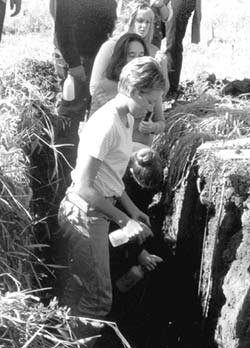V. SOIL EVALUATION CONTESTS AND RESOURCES
Site Selection, Preparation, and Official Evaluation Next Section>>
Usually the official judges at an area contest will be a NRCS Soil Scientist and a Purdue Extension Specialist. Within the farm or area selected, the judges will select four evaluation sites, supervise the back hoe digging, prepare the pit face to be judged, set slope stakes, supply standard information and special notes on the site card, and do the official evaluation a day or so before the contest. In some cases soil properties do not fit clearly into a soil evaluation class, or the practices selected according to the rules are not logical choices. In these cases, official judges should give the correct answers on the site card.
Before the contest, judges will furnish copies of the official scorecards for use by the graders. After the contest, they will conduct a critique session at each site where they read the answers, point out significant features, and answer questions from contestants and coaches.
The soil pits should be at least 48 in. deep, 24 in. wide and 8 to 12 ft. long, depending on the number of contestants (Fig. 46). Some pits may need to be deeper. The pits should be oriented so the sun will shine on one long side. On that side, a section of the profile about 1 foot wide will be marked off in which contestants are not allowed to dig. They should look at the soil in that section, but not disturb it so that all contestants can observe the same area. Usually, part of the section is picked to show soil structure and part is cut to show interior colors. This section can be marked by flags at the surface and by two yard sticks on each side secured to the soil by large nails (Fig. 47).

Fig 46. A soil judging pit with approximate dimensions. An optional 2 ft. by 2 ft. shelf to expose fragipan characteristics is shown along one side of the pit.
In contests that have or might have fragipan soils, part of each pit face should be shaved to expose vertical cracks and color contrasts that are not apparent on the natural prism faces. If possible, provide a horizontal cut to expose the polygonal pattern formed by the gray prism coatings. This surface should be flagged and the contestants not allowed to walk on or dig in it.
Two slope stakes should be set about 20-50 ft. apart. Contestants will stand near one stake and sight to the same height on the other with a slope finder to determine the slope. The slope finder card (4H-408) is available from the Purdue Media Distribution Center. Contestants need to furnish their own small water bottles (Fig. 47).

Fig 47. Observing the soil between the yardsticks.
